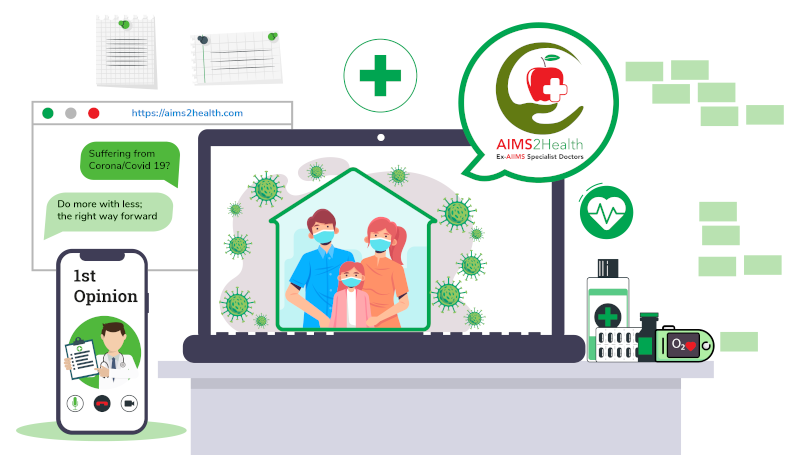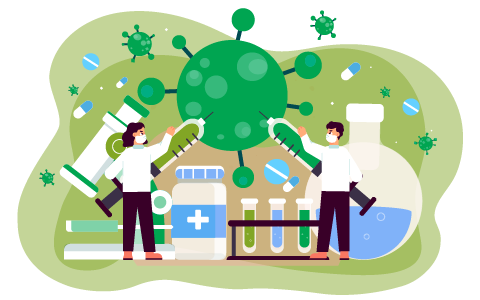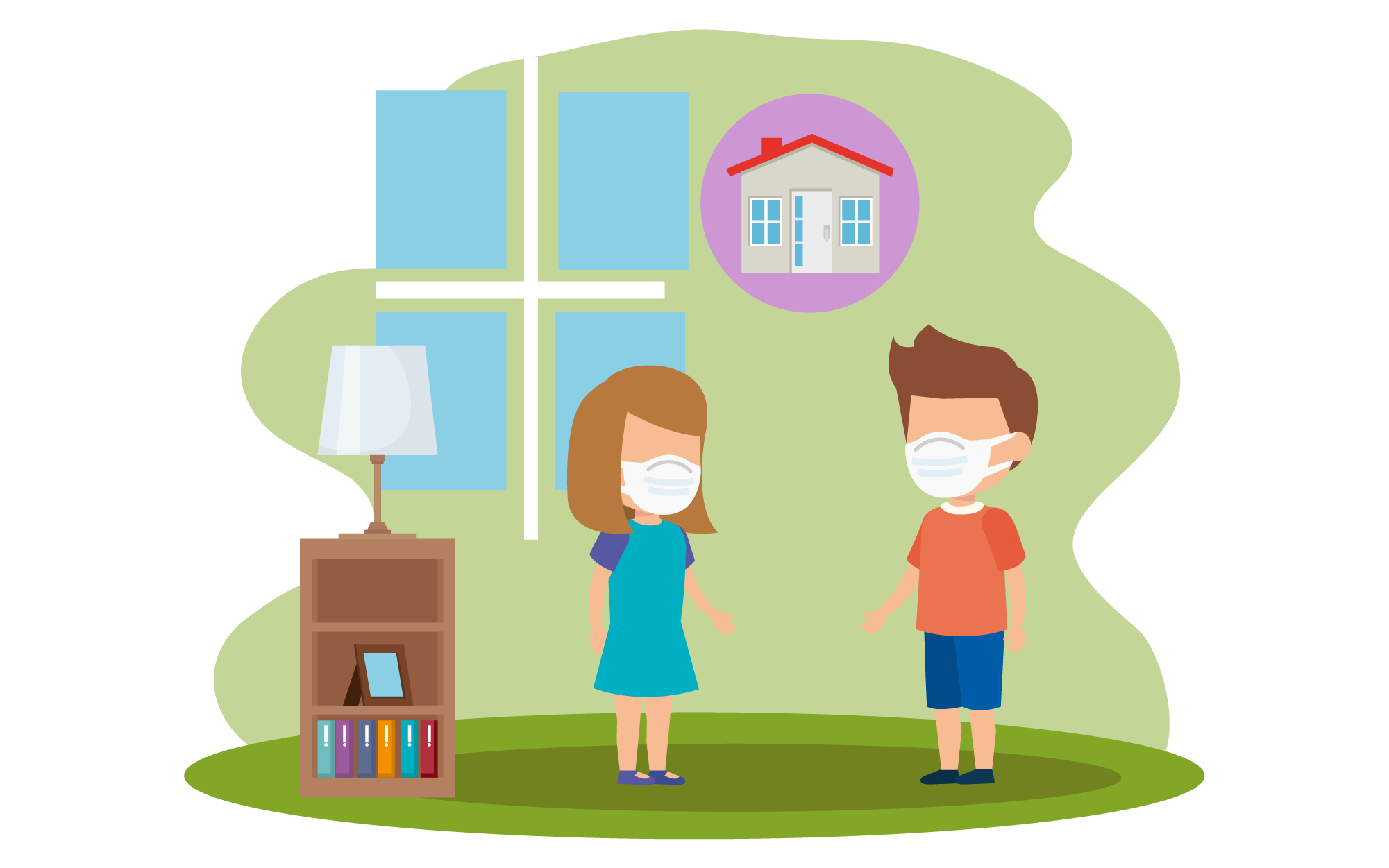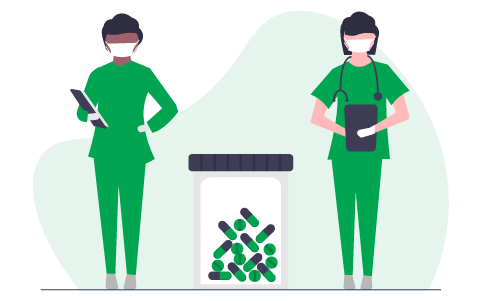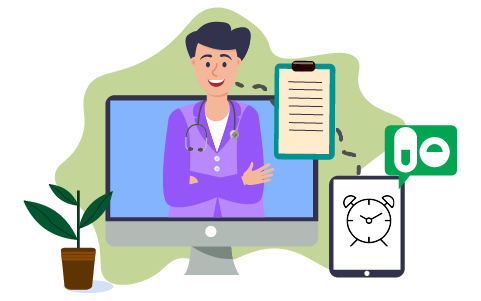What are the common symptoms of COVID-19 infection?
Common symptoms include:
- Fever, tiredness/fatigue, headache, body ache, throat pain, running nose, cough, vomiting, loose stools (diarrhea), redness of the eyes
- Most patients have mild illness, and can be managed at home
What are the common symptoms in children?
Children generally have a mild illness, and rarely need to be hospitalized. Common symptoms include:
- Fever, sore throat, cough
- Small children may have loose stools, vomiting, abdominal pain
- Older children can complain of headache, body ache and tiredness
Who are the people at high risk?
Those who:
- Are elderly, i.e., above 60 years old
- Are overweight/obese
- Have diabetes, hypertension
- Have pre-existing diseases of lungs, liver, heart or kidney
- Are on cancer treatment or immunosuppressant medicines
Follow the Standard Protocol for COVID 19 positive adults as well as presumptive positive patients:
- Strict isolation and finger Oximeter (in right hand middle finger) readings at rest and after 6 min walk thrice a day; should remain above 94%. All positive patients in the same house do not have remain in different rooms. The danger period in which oxygen level (Oximeter reading) may fall is generally from day 5 to day 11 since onset of first significant symptom, and rarely earlier or later.
- Normal diet; no restrictions . Increase protein intake; reduce carbohydrate intake. Also patient with chronic illnesses like diabetes and kidney disease should follow disease specific dietary restrictions.
- Remain well hydrated if febrile, or if you have loose motions. For those with severe heart or kidney disease should be drinking fluid within limits ( 1 to 2 litres per day, as may have been advised by their specialist doctor).
- There is no specific treatment for COVID 19/Corona virus infection. Only
symptomatic treatment is needed.
- for fever, keep a systematic record on paper. Avoid taking even Paracetamol 650 mg if fever below 102 and is not bothersome. Take maximum One Tablet, Six hourly. In some patients the fever may not ‘break’ for two weeks or longer. Please don’t worry if fever is the only symptom. Dolo 650 is also given if a patient has severe body ache, headache, severe throat pain, severe eye pain.
- Sore throat: warm saline gargles or betadine gargles, thrice a day.
- Throat irritation, sneezing or running nose: Tab Levocetirizine (Levocet) or Cetirizine (Zyrtec): One tab once a day and any home remedies. Another option is to take Tab Allegra (120 mg tablet) for runny nose, congestion or stuffiness, sneezing, itching, swelling, and watery eyes.
- Dry Cough: steam Inhalation and Tab Montair LC; one tab per day ; Wet Cough (with phlegm/sputum): Bro-Zedex Syrup, 1 or 2, teaspoons thrice daily, as long needed. Steam inhalation can be harmful if not done properly; avoid it.
- Loose motions:
- Take Electral Oral Rehydration Powder, as many times as needed;
- Tab Imodium 2 mg: two tablets first day, one tablet next three days. Preferably avoid it as it can have some significant side affects.
- Also take simply home made ‘dahi’ or yoghurt or probiotic Enterogemina once a day for 5 days.
- Eat light meals such as kitchdi with dahi, banana, daal, coconut water, etc.
- General immmunity boosters:
- Vitamin C 1000 mg, twice daily for 15 days.
- Vitamin D supplementation (tablet Tayo 60 K; once a week for seven weeks, if needed. Do blood test for Vitamin D before starting it.
- Tab Zinc 50 mg (Tab Zinconia) for 15 days
- Continue all medicines already being taken for chronic illnesses like high BP, diabetes, thyroid illnesses, asthma, cancer, arthritis, etc
What tests should be done?
- Diagnosis of Covid-19 infection can be confirmed by an RTPCR test
- Sample should be given as early as possible in the disease, preferably the day of first symptom. Viral load is higher earlier, so the chances of accurate results are higher. This will also reduce the spread of infection.
- If during the 2nd week of illness, the patient deteriorates, then other tests (such as blood test/X-ray/CT scan etc.) are required to find out how severe the illness is. The medical doctor with whom the patient is in touch with should be able to guide if/which tests are required.
- CT scan is required when the patient deteriorates and will be done by the hospital. CT scan if done early will be normal. A CT scan is expensive, and exposes the patient to radiation.
What if RTPCR test result is negative but symptoms are there?
- A negative RTPCR test result does not exclude Covid-19 infection. RTPCR test can give a false negative report in about 30 per cent cases.
- If symptoms are there, one should isolate immediately and take all necessary precautions, even if RTPCR test result is negative.
When should 2nd test be done if 1st test was negative but symptoms persist?
- The 2nd test can be done immediately, if one wishes to
- If other members in the family also have symptoms and a +ve test result, then it is likely that the person has Covid-19, even if the report is negative.
What should be done if the test result shows COVID +ve but there are no symptoms?
The person should be isolated as he/she can spread the infection to others but no treatment is required.
Blood Tests:
Normally no blood test is needed in mild cases.
Suggest get following blood tests be done on empty stomach only if baseline information on inflammation and coagulation markers in the blood is considered necessary. This is necessary in those who have severe symptoms:
- CBC
- CRP
- LFT
Those with co-morbidities (such as obesity, diabetes, high BP, asthma, kidney disease, liver disease, smokers, chronic chest diseases, history of lung tuberculosis, etc) should also do:
- Ferritin
- LDH
- D-Dimer
- Interleukin 6
Those with diabetes also do:
- Fasting blood sugar
- HbA1C
Those who are taking Thyroxine for hypothyroidism should also do:
- Thyroid Finction Tests.
Those above 70 years of age or who have had diabetes, hypertension or kidney disease, should also do:
- The KFT
Those with very severe cough (with or without sputum) for over three days should also get done. For positive patients HRCT is needed only in those where you suspect some complications, bacterial infection etc. Those with normal oxygen levels on room air or low flow oxygen don’t need HRCT. If assisted ventilation is required HRCT may be needed. CT score being done these days may have interpretation issues, and hence do not get alarmed.
- HRCT chest
Much more important than blood tests or HRCT findings are the oxygen saturation level as seen in the finger oximeter at rest and after six minute walk. Focus on your oximeter readings, which should normally be above 94%. *Check Oximeter readings in the middle finger of your dominant hand. Do so at least thrice a day. Check both at rest and after walking around the room for six minutes.
The oximeter reading remains above 94% in the vast majority of patients. Those with past history of lung problems, very elderly or smokers (even social smokers) may ‘normally’ have oximeter readings which are up to 5% lower (between 89% and 94%) than others. Normally such patients may become serious especially if their oximeter reading falls after 6 minutes of moderate exercise by more than 4% or 5%. However, if the reverse happens (Oximeter reading improves after 6 min walk) then it is reassuring that no reason to worry. In fact, it means that it is all the more important to not keep lying down in bed all the time but to walk around the room/apartment as much as the patient can.
When lying in bed the patient should lie on either side or on the stomach (prone position) for 30 to 45 min at a time a few times a day. This improves significantly oxygen supply to the lungs and that should improve the oximeter reading by as much as 3% to 5%.
- HRCT Indications:
- COVID RT-PCR negative pts who are having severe cough or very high fever for five days.
- COVID RT-PCR positive admitted patients with deterioration in clinical parameters, when course of further management is unclear.
- Symptomatic patients who are not getting access to RTPCR with wait time of upto 5 days from onset of breathless, respiratory distress, or severe cough with or without sputum
- Not to be used as a screening tool. But a lot of patients are just walking in to get it done without a doctor's recommendation, when we object , reply is ' No doc is available' also some doctors are telling patients at home to get it done. These are definitely no indications, just IMHO
When should a person be isolated?
- The moment a person experiences first symptom, he/she should be isolated immediately
- Anyone who has come in contact with a Covid +ve person should stay separate (quarantine himself/herself) and be watchful of symptoms for 7 to 10 days
What is important while isolating a COVID +ve patient?
- One should stay in a separate room (This is most important. But if not available, stay more than 6 feet away from others and in that case, all should wear a mask and should not have food together)
- Use separate bathroom, if possible (else, clean well every time after the use by a Covid +ve patient)
- The patient should wear mask all times (preferably double mask)
- Room should be ventilated i.e., windows that open outside of the house should be opened
- No one should enter that room (wear a double mask, if urgently/temporarily required to be in the room)
- Food should be served separately outside at the door of the room (anybody taking care of a Covid +ve patient should wear a double mask)
- Patient should eat within the room and wash the utensils with soap and water
- Those with Covid +ve in a family can stay together (even in the same room)
Isolation does work well to reduce spread of infection within the family and outside. It needs to be done with rigor and meticulously.
How to look after child if one/both parents are COVID +ve but child is not?
- A small child will be most comfortable with parents. If one parent is Covid -ve/does not have symptoms, the child can stay with him/her. If both are Covid +ve/have symptoms, the child should stay with them. Sending the child elsewhere may lead to spread of infection to others. The child should not be in the care of the elderly or those at high risk.
- If the child can be taught to wear a mask, he/she should be encouraged to wear a mask, if above 2 years.
How to prevent elderly/those at high-risk at home from exposure?
- Keep them separate as much as possible and reduce physical interaction with them. Avoid going close to them without masks.
- Anybody who frequently goes out to work/play and interacts with others outside, should avoid contact with them (as well as others in the family).
- They should be immediately isolated/separated whenever a case occurs in a household.
- They should be vaccinated.
How to go about domestic helps/drivers?
- Firstly, they should be told clearly that if they are not well or have any symptoms, they should inform you and not come to work.
- When they are coming, they should wash hands and wear a mask
- When they are working, try not be around at that time and if possible do not enter into that space for 20-30 minutes
- With drivers in a same cab, open windows and all should wear mask
Which mask should be used?
- N95 mask is most protective mask and is used in hospitals
- Cloth mask can help in the community (for example the saliva in case of a cough will not travel that far; if other person is also wearing a mask, the saliva will not reach out to his face). But cloth mask will not completely stop spread of a viral infection. One should not rely on cloth mask if Covid +ve patients are at home.
- Double masking can help in Covid management at home. Use a cloth mask over a surgical mask
- Mask should not be removed while talking
- Cloth mask should be washed daily (one should have more than one and rotate). Surgical mask should not be reused.
What medicines could be taken?
- Paracetamol could be taken for fever and body ache. Brand names include Crocin, Calpol, Dolo
- Adults can take 500 mg tablet 3-4 times a day. 650 mg tablet can be taken by those who have more than 80 kg of weight
- Children can take paracetamol syrup. Dose as indicated on the bottle, or the last advised dose.
- Medicines like ivermectin, doxycycline, azithromycin do not have a role in viral infection and should not be taken
- Vitamins and Zinc also have no proven benefit
- Remdesivir is to be given to a hospitalized patient, if oxygen level falls. Do not insist to your doctor to give for those who are mildly infected and are recovering at home.
- Steroids, if given early are dangerous and will worsen the viral infection. They are to be used in a sick person who has fever and a fall in oxygen saturation. They would generally be given in sick hospitalised patients.
- Inhaled steroids can be prescribed by your doctor if you have Covid-19 and persistent fever.
- You may start oxygen and steroids, if patient is sick and a hospital bed is being arranged.
What should be monitored and how?
- Body temperature with a thermometer; 3 times or when needed
- Oxygen saturation (most important); 3-4 times in a day
- To be measured with a pulse oximeter which should be purchased. Normally it is above 95 per cent.
- It can be repeated while sitting, lying down prone (it may improve; this may be helpful if oxygen value is borderline)
- If after 6 min of walk test (walking in the room or isolation area) the oxygen saturation level falls by 5 per cent or more, it is a danger sign that lung disease may happen. Please consult doctor/hospital in such case.
- Breathing rate (number of times) and breathing difficulty (discomfort in breathing)
- Oral intake, urine output should be as in healthy times.
- Alertness
- Blood pressure, pulse rate (in case of hypertensives)
- Blood sugar (in case of diabetics)
Monitoring of the elderly and those at high risk needs to be done very carefully. They can deteriorate rapidly and should be taken to hospital at the slightest sign of deterioration.
What kind of food should be eaten?
- One should eat nutritious food (adequate intake fruits and vegetables) at normal/regular timings
- Take plenty of fluids
Does steam and gargles help?
- Steam and gargles can help if there is nose block and throat pain
Should one exercise?
- One should take adequate rest and do routine exercises to the extent what is possible with body ache
- It is good to walk within the room or isolation area
- Breathing exercises should be done
Is there any posture that can help when Oxygen saturation is low?
Saturation can improve by sitting, by lying down prone (on the stomach), or by breathing deeply. Please contact your doctor or hospital if saturation is falling.
How to stay mentally healthy?
- Follow regular routine
- Stay in touch on social media with near and dear ones (friends/relatives)
- Do not listen to negative news
- Develop a hobby that you like
Who can continue to stay at home?
Anybody who has a mild disease, with oxygen saturation more than 95 per cent, normal breathing, and is able
to eat and drink well can stay at home
Note: The patient should remain in touch with his/her regular/family doctor while staying at home and
update about symptoms and results of regular monitoring
When should one go to hospital?
- If the oxygen saturation level falls (most important criteria)
- Below 95 per cent (in case of high-risk people as mentioned above)
- Below 90 per cent (in the case of healthy adults), though a fall of 5 percentage points is of concern.
- In case of difficulty in breathing or fast breathing (in adults, more than 30 times per minute is considered fast)
- If unable to eat and drink
- If feeling very drowsy
- Fever persisting over a week or recurring
How does vaccination helps?
- Available vaccines can prevent serious disease. Whoever is eligible should get themselves vaccinated.
- When going for vaccination, wear a well-fitting mask and do not remove
- Make sure that the 2nd dose of vaccination is of the same brand. Take vaccination certification of the 1st dose along or inform about the vaccine which was given earlier.
When should the RTPCR test be repeated?
The patient would be non-infective after 10 days of the onset of symptoms and at the same time should have no fever for the last 3 days. There is no need to repeat the RTPCR test. One can after that mingle with other family members.
When should one go outside?
- One should go outside the house only for essential/urgent work
- Should not go out for recreation and meeting people. Outdoors and away from other people is still safer but could be avoided under current circumstances.
- It is important to follow Covid appropriate behavior i.e., wearing mask, keeping distancing of more than six feet and washing hands
Note:
- Please do not give/take Fabiflu (Favipiravir) Doxycycline, Ivermectin or Azithromycin as none of these has any proven role. These may harm the patient as all medicines have side effects. Most common side effects of most of these drugs are nausea, vomiting, abdominal pain, loose motions. These unfortunately are also symptoms of the illness.
- Steroids (Medrol/Dexona) are prohibited and dangerous for those having normal oximeter reading. Only those who need more than 3L/min supplemental oxygen support should receive a short course for five days. Early start of steroids can make the condition worse and even cause death.
- Neither Inj Remdesivir nor convalescent Plasma is of proven value. So do not worry too much if these cannot be arranged. Neither of these will change the final outcome.
- Much more important than blood tests or HRCT findings is the oxygen saturation level as seen in the finger oximeter. This is the key to management of Covid 19.
Q-1: I have fever upto 100, do I need to get Covid test done?
Yes.
Q-2: My husband is Covid positive, and I have also developed fever, do I need to get Covid tested?
Yes.
Q-3: My wife got tested for Covid after 5 days of fever, it came positive, I am asymptomatic, do I need to get Covid tested?
Wait till you develop any of the common symptoms (such as fever, body ache, headache, blocked nose, irritation or pain in throat, loss of smell or taste, or unexplained nausea/vomiting/loose motions) before you get the test done. Isolate yourself from all others, meanwhile.
Q-4: My husband is on home quarentine, after how long can we let him mix with family?
17 days after start of first symptom or 10 days after end of last symptom, which is later, unless a COVID test (RT-PCR) done after 10 days of onset of first symptom is negative.
Q-5: My husband has Covid, and he is fine, now for 1 week, when is the right time to safely let our children meet with him?
Same answer as above (4).
Q-6: I have fever (100-101) and I am tested positive: I have no co-morbidities:
-
further tests do I need and when?
-
should I start taking treatment proposed by some medical specialists on WhatsApp?
-
Is there a need to take video consultation?
-
When should I seek to get admission in the hospital?
No tests needed if fever is the only symptom even if it persists unbroken for two weeks, provided your finger oximeter reading remains above 94%.
No specific treatment needed. Only take one tablet of Dolo 650 mg if fever goes above 101, and do not take it take it more often than once in six hours; if you can manage with fewer tablets than four in 24 hrs, the better.
Not really, unless you have a dip in your oximeter reading or your develop other symptoms such as severe headache, severe vomiting or severe loose motions.
Only if your Oximeter reading at rest in room air is below 94% and dips below 90% after a six minute walk.
Q-7: I have fever (100-101) and I am tested positive: I am a controlled diabetic.
-
what further tests do I need and when?
-
Is there a need to take video consultation?
-
Should I seek to get admission in the hospital?
Check your blood sugar regularly as often there is a need to increase the dose of existing diabetes medicines as blood sugar level often goes up during the illness. Keep your blood sugar under good control.
Only if your blood sugar has gone up and you do not know how to adjust dose of your diabetes medications, or you have developed other severe symptoms which need attention.
Only if you are unable to manage your diabetes at home, or because of other severe symptoms or severe fall in oximeter reading as explained above.
Q-8: I have recieved 2 doses of Vaccine, and have developed fever, could I have still caught Covid.
Yes, but normally you will have only mild or at worst moderate symptoms.
Q-9:What is the risk in my visiting my neighbour, who has returned from hospital after Covid treatment. If there is, how to minimise, and till when?
Find out first whether the patient is RT-PCR negative for COVID 19, or atleast ten days have elapsed since the last symptom has abated. Even then maintain social distance and wear a mask properly during the visit.
Q-10: What is the level of SpO2, below which I should seek hospitalisation?
If below 94% at rest and below 90% after 6 min walk, unless you can arrange supplemental oxygen at home through an oxygen concentrator or oxygen cylinder and high flow nasal canula.
Q-11: Is there any other reason, other than low Oxygen, for which hospitalisation is required?
If you are dehydrated, are totally unable to eat or drink, or have a doubt of having suffered a heart attack or a stroke.
Q-12: Everyone in my family is RT-PCR COVID 19 positive. My report is negative but I have the same symptoms like all others.
-
Am I also infected?
-
Do I need to repeat the test before starting symptomatic treatment?
-
Do I need to isolate myself from others in my house who are positive lot just recovering/recovered from it?
Yes
No
No
- Protocol & FAQs
- Standard Protocol
- Blood Tests
- Do Not
- have fever upto 100, need to get Covid test?
- Family member is Covid positive, should I need Covid test?
- Family member is Covid positive, I am asymptomatic, do I need to get Covid tested?
- After how long can we let him mix with family, after quarentine?
- has Covid for 1 week, now he is fine,when is the right time to safely let our children meet with him?
- I have fever (100-101) & tested positive with no co-morbidities:
- I have fever (100-101) & tested positive with controlled diabetic
- could I have still caught Covid after vaccinated twice.
- The risk of visiting my neighbour after Covid treatment
- Level of SpO2, below which I should seek hospitalisation?
- Other reason excepts low Oxygen level required hospitalisation?
- Other family member are RT-PCR COVID 19 positive. I am negative but I have the same symptoms like all others.

